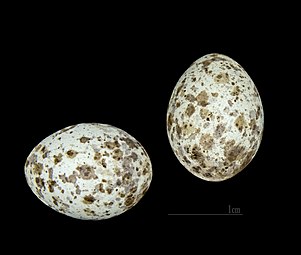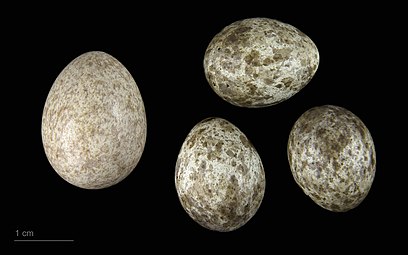| Common reed warbler | |
|---|---|

| |
| Song recorded in Surrey, England | |
| Conservation status | |
 Least Concern (IUCN 3.1) | |
| Scientific classification | |
| Domain: | Eukaryota |
| Kingdom: | Animalia |
| Phylum: | Chordata |
| Class: | Aves |
| Order: | Passeriformes |
| Family: | Acrocephalidae |
| Genus: | Acrocephalus |
| Species: | A. scirpaceus |
| Binomial name | |
| Acrocephalus scirpaceus (Hermann, 1804) | |
| Subspecies | |
|
See text | |

| |
| Distribution Breeding range Resident year-round Passage Non-breeding range | |
The common reed warbler (Acrocephalus scirpaceus) is an Old World warbler in the genus Acrocephalus. It breeds across Europe into the temperate western Palaearctic where it is migratory, wintering in sub-Saharan Africa. It is also a resident species over large parts of Africa.
Taxonomy
The common reed warbler was formally described in 1804 by the French naturalist Johann Hermann under the binomial name Turdus scirpaceus. The type locality is Alsace. The common reed warbler is now one of around 40 species placed in the genus Acrocephalus that was introduced by Johann Andreas Naumann and his son Johann Friedrich Naumann in 1811. The genus name Acrocephalus is from Ancient Greek akros, "highest", and kephale, "head". It is possible that the Naumanns thought akros meant "sharp-pointed". The specific scirpaceus is from Latin and means "reed".
Ten subspecies are recognised:
- A. s. scirpaceus (Hermann, 1804) – breeds in Europe to west Russia, Ukraine and west Turkey, northwest Africa, winters in west, central Africa
- A. s. fuscus (Hemprich & Ehrenberg, 1833) – breeds in north Egypt and central Turkey through the Middle East to southeast European Russia, north Iran, Kazakhstan and northwest China; winters in eastern and southern Africa
- A. s. avicenniae Ash, Pearson, DJ, Nikolaus & Colston, 1989 – coasts of the Red Sea
- A. s. ammon Hering, Winkler & Steinheimer, 2016 – Oases along the Libya-Egypt border region
- A. s. ambiguus (Brehm, AE, 1857) – Iberian Peninsula and northwest Africa
- A. s. minor Lynes, 1923 – Sahel region from Senegal to west-central Sudan (Darfur)
- A. s. cinnamomeus Reichenow, 1908 – west Ethiopia and south Somalia south through South Sudan, Uganda, Kenya, Zambia and Mozambique; patchy distribution in west Africa from south Cameroon to possibly Niger and Mali
- A. s. suahelicus Grote, 1926 – east Tanzania to east Mozambique and eastern South Africa
- A. s. hallae White, CMN, 1960 – southwest Angola to southwest Zambia and south to western South Africa
- A. s. baeticatus (Vieillot, 1817) – north Botswana and Zimbabwe to southern South Africa
An older scientific name for the reed warbler was Acrocephalus streperus (Vieill.).
The mostly resident Iberian and African subspecies are sometimes treated as a separate species, the African reed warbler (Acrocephalus baeticatus).
Description
This is a medium-sized warbler, 13 cm (5.1 in) in length with a wing-span of 17–21 cm (6.7–8.3 in). The adult has an unstreaked brown back and buff underparts. The forehead is flattened, and the bill is strong and pointed. The sexes are identical, as with most warblers, but young birds are richer buff below. The common reed warbler looks similar to the great reed warbler, but the great reed warbler is larger in size and has a stronger supercilium.
The song is a slow, chattering jit-jit-jit with typically acrocephaline whistles and mimicry added.
Distribution and habitat
This small passerine bird is a species found almost exclusively in reed beds, usually with some bushes. They can also be found in damp scrub.
Behaviour and ecology
Food and feeding
Like most warblers, it is insectivorous, but will occasionally take plant material such as berries.
Breeding
The males return to the breeding grounds two or three weeks before the females. The species is usually monogamous. The first eggs are laid at the end of April. The nest is usually placed in vegetation over water, especially in reeds of the genus Phragmites. The deep cylindrical cup nest is sited on average 65 cm (26 in)—range is between 20 and 140 cm (7.9 and 55.1 in)—above the surface of the water and is built entirely by the female. She takes four days to build the initial cup of grass, reed stems and leaves, and another three days to complete the lining of finer material including hair. The clutch contains three to five eggs that are laid daily. The eggs are very pale green with speckles and blotches of olive green or grey. On average they measure 18.4 mm × 13.6 mm (0.72 in × 0.54 in) and weigh 1.75 g (0.06 oz). They are incubated by both parents, beginning after the penultimate egg is laid. Only the female incubates at night. The eggs hatch after 9–12 days. The nestlings are fed and cared for by both parents. They fledge after 10–12 days but continue to be fed by their parents for another 10–14 days. Up to one third of pairs raise a second brood.
The common reed warbler is one of the species that are brood parasitised by the common cuckoo.
Gallery
-
 Placement of nest
Placement of nest
-
 View of nest with clutch
View of nest with clutch
-
 Reed warbler eggs
Reed warbler eggs
-
 Cuculus canorus canorus egg in a clutch of Acrocephalus scirpaceus - MHNT
Cuculus canorus canorus egg in a clutch of Acrocephalus scirpaceus - MHNT
-
 Common cuckoo chick fed by reed warbler adult
Common cuckoo chick fed by reed warbler adult
References
- BirdLife International (2019) . "Acrocephalus scirpaceus". IUCN Red List of Threatened Species. 2019: e.T22714722A155436305. doi:10.2305/IUCN.UK.2019-3.RLTS.T22714722A155436305.en. Retrieved 25 January 2020.
- Hermann, Johann (1804). Observationes zoologicae quibus novae complures, aliaeque animalium species describuntur et illustrantur (in Latin). Argentorati : Amandum Koenig. pp. 202–203.
- Mayr, Ernst; Cottrell, G. William, eds. (1986). Check-list of Birds of the World. Vol. 11. Cambridge, Massachusetts: Museum of Comparative Zoology. p. 62.
- ^ Gill, Frank; Donsker, David; Rasmussen, Pamela, eds. (January 2022). "Bushtits, leaf warblers, reed warblers". IOC World Bird List Version 12.1. International Ornithologists' Union. Retrieved 12 June 2022.
- Jobling, James A. (2010). The Helm Dictionary of Scientific Bird Names. London: Christopher Helm. pp. 30–31, 350. ISBN 978-1-4081-2501-4.
- Ash, J.S.; Pearson, D.J.; Nikolaus, G.; Colston, P.R. (1989). "The mangrove reed warblers of the Red Sea and Gulf of Aden coasts, with description of a new subspecies of the African Reed Warbler Acrocephalus baeticatus". Bulletin of the British Ornithologists' Club. 109: 36–43.
- Babbington, J.; Boland, C.; Kirwan, G.M.; Alsuhaibany, A.; Shirihai, H.; Schweizer, M. (2019). "Confirmation of Acrocephalus scirpaceus avicenniae (Aves: Acrocephalidae) from mangroves on the Red Sea coast near Jazan, southwest Saudi Arabia". Zoology in the Middle East. 65 (3): 201–207. doi:10.1080/09397140.2019.1604470. S2CID 155777594.
- Hering, J.; Winkler, H.; Steinheimer, F.D. (2016). "A new subspecies of Eurasian Reed Warbler Acrocephalus scirpaceus in Egypt". Bulletin of the British Ornithologists' Club. 136: 101–128.
- Vieillot, Louis Pierre (1817). Nouveau dictionnaire d'histoire naturelle, appliquée aux arts, à l'agriculture, à l'économie rurale et domestique, à la médecine, etc (in French). Vol. 11 (Nouvelle édition ed.). Paris: Deterville. p. 195. doi:10.5962/bhl.title.20211.
- For instance in Naumann, Johann Friedrich (1897). Naturgeschichte der Vögel Mitteleuropas. Vol. 2. OCLC 603365339 (all editions).; see also: [REDACTED] image on Wikimedia Commons.
- Dyrcz, A.; Christie, D.A.; Garcia, E.F.J. (2020). Billerman, S.M.; Keeney, B.K.; Rodewald, P.G.; Schulenberg, T.S. (eds.). "Eurasian Reed Warbler (Acrocephalus scirpaceus), version 1.0". Birds of the World. Ithaca, NY, USA: Cornell Lab of Ornithology. doi:10.2173/bow.eurwar1.01. S2CID 241415727. Retrieved 26 August 2022.
- Olsson, U.; Rguibi-Idrissi, H.; Copete, J.L.; Arroyo Matos, J.L.; Provost, P.; Amezian, M.; Alström, P.; Jiguet, F. (2016). "Mitochondrial phylogeny of the Eurasian/African reed warbler complex (Acrocephalus, Aves). Disagreement between morphological and molecular evidence and cryptic divergence: A case for resurrecting Calamoherpe ambigua Brehm 1857". Molecular Phylogenetics and Evolution. 102: 30–44. Bibcode:2016MolPE.102...30O. doi:10.1016/j.ympev.2016.05.026. PMID 27233439.
- Cramp 1992, p. 193.
- Campbell, Donald (2000). Walters, Martin (ed.). The Encyclopedia of British Birds. Bath: Parragon. p. 254. ISBN 0752541595.
- Cramp 1992, pp. 198–201.
- Cramp 1992, p. 203.
- Cramp 1992, p. 201.
- Cramp 1992, pp. 208–209.
- Davies, N.B.; Brooke, M. De L. (1989). "An experimental study of co-evolution between the cuckoo, Cuculus canorus, and its hosts. I. Host egg discrimination". Journal of Animal Ecology. 58 (1): 207–224. Bibcode:1989JAnEc..58..207D. doi:10.2307/4995. JSTOR 4995. S2CID 56303051.
Sources
- Cramp, Stanley; et al., eds. (1992). "Acrocephalus scirpaceus Reed Warbler". Handbook of the Birds of Europe the Middle East and North Africa. The Birds of the Western Palearctic. Vol. VI: Warblers. Oxford: Oxford University Press. pp. 193–212. ISBN 978-0-19-857509-2.
External links
- Eurasian reed warbler videos, photos & sounds on the Internet Bird Collection
- Avibase
- Ageing and sexing (PDF; 2.3 MB) by Javier Blasco-Zumeta & Gerd-Michael Heinze Archived 2016-11-08 at the Wayback Machine
Bibliography
- Kishkinev, D., Chernetsov, N., Pakhomov, A., Heyers, D., and Mouritsen, H. (2015). Eurasian reed warblers compensate for virtual magnetic displacement. Curr. Biol. 25, R822–R824